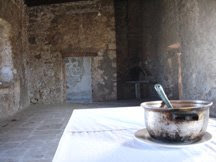we don't really define one pot as an underground restaurant - the project is more clearly about "the table" as an institution, archetype, cultural icon, tool, and place to make work.
the project i started in 2001 called family supper was much more a specific "underground" or unlicensed restaurant - and was meant as a tool kit for others - a way to challenge the conventions of the restaurant and allow others to do the same - some people say that family supper started a movement - i think it is simply part of an ageless continuum - people will always challenge the bureaucracy that surrounds them - civil disobedience is essential to any vital culture - food has been regulated/policed/and sterilized since time began - in one form or another - this new "movement" is just a contemporary challenge to the status quo - but that said - it is people using a table imaginatively and critically and thus should be considered part of this index.
the press loves this "movement" - here is a limited selection of the major and some minor articles:
(we are presently working on getting all of these articles linked - in the meantime go to
killtherestaurant.com - same list - with active links)
the new york times + family supper, mamasan bistro, firefly
the international herald tribune + one pot
gq + outstanding in the field
the new york post + ghetto, one pot, homeslice
the wall street journal + ghetto gourmet, one pot, supper underground
la times + ghetto, family supper, and many more
ny times magazine + coach peaches, paris, berlin
marketplace + ghetto gourmet
the guardian + london, cuba, yountville
time magazine + ghetto gourmet
the splendid table + one pot
san francisco chronicle + ghetto gourmet, blind pig, digs
time out chicago + coach peaches.= link coming soon
ny times magazine + outstanding in the field
corriere della sera + family supper= link coming soon
bon appetit + supper underground, ghetto, homeslice
travel + leisure + one pot= link coming soon
cbs morning show + family supper=link coming soon
the new york times + one pot
better homes and gardens + family supper = link coming soon
seattle monthly + one pot
anthony bourdain + gypsy chefs= link coming soon
oakland tribune + ghetto gourmet
the stranger + one pot
seattle weekly + one pot, vagabond
seattle times + gypsy chefs
cbs + homeslice west , ghetto
house and garden + outstanding in the field
alaska airlines + outstanding in the field
seattle monthly + gypsy, vagabond, cache= link coming soon
plum tv + outstanding in the field
seattle weekly + gypsy chefs
california style + outstanding in the field
sunset + plate n pitchfork, outstanding in the field
outside + outstanding in the field
elle + outstanding in the field
metro active + the blind pig
the orange county register + ghetto gourmet
sacramento news and review + hidden kitchen
the new york times + buenos aires
reed college magazine + one pot
reed college magazine + kill the restaurant
tribeza + supper underground
ready made + grub
austinist + supper underground
expatica + club 11
taipei times + malaysia
joburg + joburg underground
mong kok times + death sentence
edible brooklyn + grub
cabinet magazine + marinetti
the prague post + prague undergound
the write word + vancouver b.c.
det progressiva + ghetto, gypsy, one pot, supper underground
daily candy + one pot
chicago suntimes + wellfleet
the new york times + z kitchen
LAist + ghetto gourmet
oc register + ghetto gourmet











